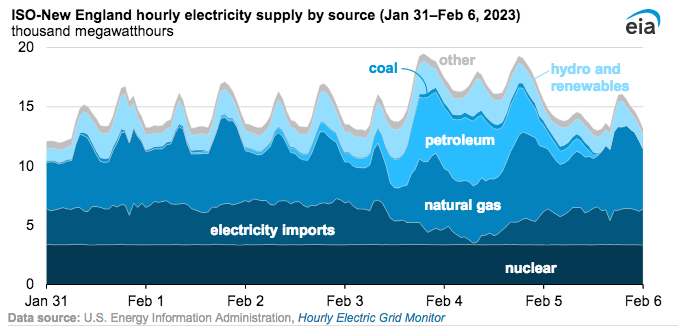New England grid withstands Arctic conditions – by bringing coal and oil PPs online
14 February 2023
 The US Energy Information Administration reports that from 3-5 February record-breaking low temperatures and extreme wind chill in New England resulted in unusually high electricity demand as homes and businesses turned up the heating. However, the region’s power grid avoided blackouts and met heightened demand, although it was obliged to bring coal and gas plant online to achieve it.
The US Energy Information Administration reports that from 3-5 February record-breaking low temperatures and extreme wind chill in New England resulted in unusually high electricity demand as homes and businesses turned up the heating. However, the region’s power grid avoided blackouts and met heightened demand, although it was obliged to bring coal and gas plant online to achieve it.
During the cold snap, temperatures ranged from -10°F in Boston, the lowest temperature recorded in the city since 1957, to -25°F in northern New England. Powerful winds added to the cold. Wind chill records were set in cities across New England, including Boston, where the wind chill factor resulted in an effective temperature of -39°F
For the three days of extreme cold, hourly electricity demand in ISO-New England peaked at 19 487 MWh, at 7:00 p.m. eastern time on 3 February, based on data from our Hourly Electric Grid Monitor. Demand approached that level again on the evening of Saturday, February 4, when it reached 19 287 MWh. The all-time high in winter peak demand in ISO-NE was 22 817 MWh in January 2004.
Hourly electricity demand remained above 16 000 MWh for 32 consecutive hours during the arctic blast, from 3 to 4 February. On a typical winter day, hourly electricity demand in ISO-NE peaks around 16 000 MWh, falling to less than 14 000 MWh at night.
To help meet demand, grid operators called on power plants that aren’t typically used, including more than 5000 MW of oil-fired power plant as well as the region’s last remaining coal-fired plant, one that sends all of the electricity it generates to the grid, Merrimack Station in New Hampshire. These plants ran during the entire cold weather event. Generation at these plants was phased out on 5 February, as conditions warmed.
Extreme weather events like the recent storm and the resulting spikes in electricity demand have stressed power grids in regions across the country. In response, the North American Electric Reliability Corporation and the Federal Energy Regulatory Commission (FERC) have launched a national study examining electric supply reliability.
Image: New England grid Jan-Feb 2023 (courtesy of US Energy Information Administration)

